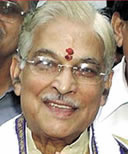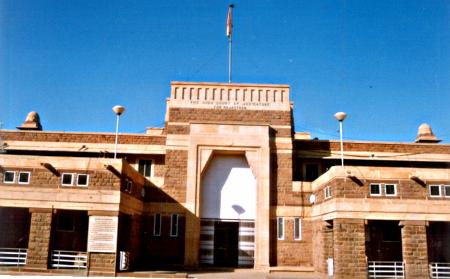|
BITS, Pilani since its
inception as a Deemed University in 1964 has admitted
students purely on merit. Till 1972, merit was based on the
total marks obtained in the qualifying examination; the
subjects considered being Physics, Chemistry and Mathematics
(PCM) for engineering. This system was also followed by
Delhi College of Engineering and most Regional Engineering
Colleges.
From 1970 to 1980, several
changes were introduced including the integrated curriculum,
Practice School and the Dual Degree Programs. Indian
schooling also changed to the 10+2+4 system. BITS moved to
four year degree programs instead of five years.
In 1972, BITS introduced a new admissions policy, admitting
its students on the basis of normalized percentage of marks.
This was also the time when the "Unassigned System of
Admissions" was introduced. This was immensely
unpopular and was discontinued partially in 1978 and
completely in 1979.
From 1979 onwards,
programs were classified as Groups A, B and C programs,
which was significant since it assured all group B programs
a dual degree from one of the programs of Group A.
Dr. G Raghurama, Dean of
Admissions at BITS Pilani, says "The Institute decided
on the scheme of normalized percentages of marks in order to
remove the disparity in the evaluation systems of different
boards in the country. This method worked well over the
years. It was a new and unique system which was highly
appreciated."
A
COMMENT ON BITS DIVERSITY
Prior
to 1970's, BITS predominantly had students from one state -
Rajasthan. Then students began coming from places closer,
Delhi, UP etc. There were a few persons from the South, and
even then those were the persons who were living in Delhi,
etc. By the mid-to-late 70s, geographical distribution of
students does not appear to be an issue, although the
majority of the students were from North India, since there
was a good dispersion of students amongst all regions
including excellent Southern representation.
Chandra Bhople ('74 Maharashtra-resident) remembers his
days. "Even though BITS was really popular in the South
especially Tamil Nadu and people would sometimes consider
going to BITS instead of IIT, still we used to have
substantial people from other boards as well. The diversity
was as good as it can get." The geographic diversity of
BITS probably peaked during the early 80s.
The rise of the South
Dr. Raghurama says
"Starting in 1985, large numbers of students from the
southern parts of India started applying to BITS. Many
regions in South India had the concept of seat reservations
for the backward classes, following which the so-called
'forward classes' had reduced opportunities in Institutes
present in these areas."
Venu Palaparthi ('87 CBSE
Board and Hyderabad resident) says "In 1987, out of the
500-odd students, approx. 150 were from AP, which was less
than the 200-odd TN contingent. Barring a year or two, I
have seen a gradual increase in the numbers of AP students,
who equaled TN in numbers by the time I graduated." He
goes on to add that "On a recent trip to Pilani, I was
struck by the overwhelming number of Andhra students I met.
The percentages are clearly much higher now."
Ganesh Venkatraman (Phy
EEE '95 and a Chennai resident) concurs: "Through the
'95-'99 batches at BITS the percentage of students from AP
and TN were approximately 60-70%. While I don't know this
for a fact or have verifiable numbers on it, I do believe
this is the general perception and is reasonably
accurate." Ganesh adds that "At least until 2000,
most students from CBSE were from TN."
Over the last two decades,
students from TN and AP appear to have kept an even grip on
Pilani seats. Abhijit Pethe ('97 EEE) agrees that during the
time he was in Pilani, 80% of the seats used to go to
students from the South with those percentages becoming
higher and higher closer to 2001.
The strong showing of AP
students has been responsible for much of these increases.
Unverified numbers suggest that substantially more than 50%
students at BITS Pilani campus came from AP in 2003. In
2004, we understand that this percentage on the Pilani
campus fell due to some changes made by BITS with respect to
AP Board results. But, in its first year of admissions, a
very significant majority of the 560 students entering Goa
in 2004 came from AP, according to a student at BITS
Pilani-Goa.
As awareness increased
about the BITS Pilani policy of admitting students on merit,
and greater numbers were admitted, it created a cycle of
even greater applications from the South. Today, 80% of the
10,000 applications received by BITS Pilani every year are
from the five Southern states.
The Success of Andhra Pradesh
Chandrababu Naidu was a
big supporter of higher education, and his efforts have
reaped rich dividends for the state's aspiring students. His
government paid Rs 20,000 per year to every AP student who
got admitted into BITS or IIT, effectively providing them
with a free education. AP students have done well, thanks in
part to the incentives, and the popularity of engineering as
a career in the state.
AP has several schools
that are "factories" fine tuned to producing high
marks in Class XII exams, such as Vignan, that (according to
their own website), contributes 30-60 students to BITS every
year. This is similar to the coaching institutes for JEE in
Kota, a topic we will touch on in the next article. AP
students do well at IITs, although the percentages are
significantly lower. Nagendar Bandi ('98 IIT Guwahati) says
"Approx. 16% of all IIT JEE seats were filled by AP
students in 1998". A significant number come through
the Ramaiah, Nalanda and Gowtham IIT coaching institutes.
Andhra students reportedly
do significantly better on the AIEEE. One student reported
that they have taken more than 50% of the available AIEEE
seats last year.
 This
clearly shows the outstanding performance, ambition and
determination of the AP student, especially when it comes to
AIEEE and Board exams. This
clearly shows the outstanding performance, ambition and
determination of the AP student, especially when it comes to
AIEEE and Board exams.
However, the enormous
percentages of AP students in Pilani resulted in rumblings
amongst the alumni when an alum visiting Pilani in 2003
observed in an email on a BITSAA yahoogroup that he saw and
heard that over 70% of the students admitted to BITS were
from AP in 2003.
Venu explains the
popularity of BITS. "In 1987, students were generally
coming from urban areas such as Hyderabad, and were
generally split between the CBSE and AP Board." He adds
that "As awareness about BITS Pilani increased in other
areas of AP, and amongst AP Board students, with their
advantage of being allowed to write improvement exams for
the 11th grades, the numbers just exploded, which reflects
the current population."
The
Battle Begins: Thanks to Murali Manohar Joshi
In a separate an unrelated
action, in October 2001, according to Dr. Raghurama “The
Government of India passed a resolution stating that all
engineering, architecture and pharmacy seats in the country
will have to be filled only by IIT-JEE, AIEEE or State Level
Entrance examinations. While the IITs were allowed to carry
on with their exams, it was made compulsory for all other
universities having other modes of admissions to join the
AIEEE. The reason given by the government was that it would
help reduce multiplicity of exams, ease the financial burden
and tension on students. The AIEEE exams would be based on
the common minimum syllabus, which students, irrespective of
the board they come from would be able to attempt uniformly.
“
Dr.
Raghurama says “It is important to note that the
normalization method was not being challenged by anyone,
including the government. The issues involved were much
bigger, including the autonomy of a university, the role of
government and UGC on university affairs etc.”
Dr.
Raghurama indicates that BITS immediately expressed its
unwillingness to join the AIEEE citing three reasons.
Firstly, the government resolution violates Article
19 of the constitution of
India
, which says that the admission procedure is the prerogative
of the Institute. Secondly, the current method is a fair,
transparent purely merit-based system with no quota or
reservations. Lastly, the planned system was discriminatory
- JEE for IITs, AIEEE for everyone else.
BITS offered alternatives
to its current system that should be followed for all
schools in
India
. The government ignored its wishes, and BITS went to court.
 Joshi
moved on this matter. Although the normalization method was
itself not being challenged, the issue was a bigger one,
involving the autonomy of a university and the role of
government and UGC in university affairs. Joshi
moved on this matter. Although the normalization method was
itself not being challenged, the issue was a bigger one,
involving the autonomy of a university and the role of
government and UGC in university affairs.
BITS immediately expressed its
unwillingness to join the AIEEE citing three reasons.
Firstly, the government resolution violates Article 19 of
the constitution of India, which says that the admission
procedure is the prerogative of the Institute. Secondly, the
current method is a fair, transparent purely merit-based
system with no quota or reservations. Lastly, the planned
system was discriminatory - JEE for IITs, AIEEE for everyone
else.
BITS
offered alternatives to its current system that should be
followed for all schools in India. The government ignored
its wishes, and BITS went to court.
BITS Goes To Court
BITS
filed a case in the Rajasthan High Court regarding the
enforcement of this Central Government policy to dictate the
admission procedure.
An interim order was passed by the Rajasthan High court
allowing BITS to carry on admissions in its own way.
Later in April 2004, BITS got a permanent judgment in the
case. On this basis the Admissions Office went ahead with
the advertisement for the admissions process.
 But
the Government moved the division bench of the Rajasthan
High Court against BITS, and the case was heard all over
again. The division bench reversed the earlier
decision, and ruled that BITS should join AIEEE. By that
time, AIEEE exam had already been conducted for 2004 and
there was no way BITS aspirants could take it if they had
not done so already. But
the Government moved the division bench of the Rajasthan
High Court against BITS, and the case was heard all over
again. The division bench reversed the earlier
decision, and ruled that BITS should join AIEEE. By that
time, AIEEE exam had already been conducted for 2004 and
there was no way BITS aspirants could take it if they had
not done so already.
BITS had already received
more than 10,000 applications based on its advertisement. It
was a trying time; the court was on vacation till July,
which meant BITS was in danger of not being able to conduct
an admissions process at all that year. The HRD
Ministry was not sympathetic.
BITS management notified
the applicants of the switch to AIEEE, which enraged many
students who were sure of getting into BITS. Some of
these affected students moved the Supreme Court. The Supreme
Court then ‘stayed’ the Rajasthan High Court order and
decided to allow BITS to conduct admissions using their
original criteria.
MM Joshi Departs!
With the change in
government, on Oct 1st, 2004 the new ministry passed a
notification stating that autonomy would be given back to
all universities and that it was no longer necessary for
deemed universities to join the AIEEE. This supports the
stand taken by BITS all along.
in
conclusion
Although the court case had
nothing to do with the normalization process or the rise in
AP students at BITS, the timing of the case resulted in
significant discussions and deliberations at BITS to start
working towards a new admissions process. The case should
never have gone to court, but it had an unexpected outcome
generating healthy debate and a proposal for a unique new
examination by BITS Pilani.¨
|

